Kano Model Examples - Build Great Products With a Simple Mental Model

When in 2007 Steve Jobs first showed the original iPhone it seemed out of this world. Watch the event video and pay attention to the crowd reaction when Jobs shows pinch-to-zoom or when the phone automatically switches to landscape mode when he flips it in his hand. It was unbelievable.
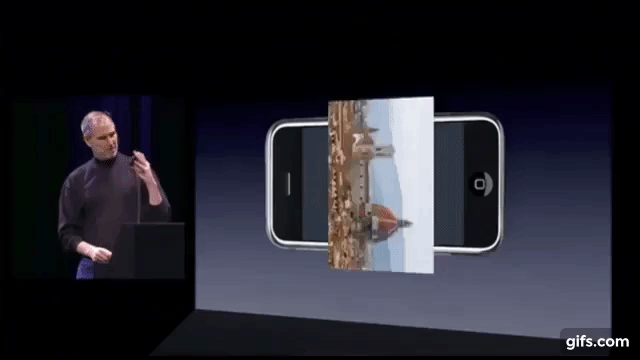
Few years later, there are thousands of smartphone models. Every single one has the pinch-to-zoom feature and switches to landscape mode automatically. You would seriously reconsider buying a phone lacking these features - it would feel weird.
This is a general property of any product or service - over time, amazing new features become basic, expected, boring attributes. Anyone offering a competitive product has to have these features for a satisfactory user experience.
It turns out there's a mental model that helps us thing about this dynamic. Dating back to 1980s, it originates from Japan and is known as the Kano Model after its original author, Noriaki Kano.
If you read on you'll find a brief description of Kano model, leaving out the details but more than enough to understand the intuition behind it. We'll then look at several Kano model examples, namely case studies showcasing how the model can be used in different settings.
In short, we'll see an example of a pyramid of customer needs, akin to Maslow's hierarchy, drawn from airline industry. Understanding products, services and feature ideas in terms of Kano hierarchy of customer needs can help us come up with product strategies and roadmap planning.
Then we'll look at how the Kano thinking can be used to understand Tesla's strategy to break into automotive industry and how we can use these ideas to find product-market fit.
Finally, we'll glance at how traditional hotels are fighting back against Airbnb and what they're doing wrong.
What is the Kano Model?
Kano model posits that you can put any feature of any product or service into one of the following buckets:
- Reverse quality - these are product attributes that when present are reducing customer satisfaction, and you'd be better off removing them.
- Indifferent - attributes that don't affect satisfaction regardless of whether they're present or not
- Must-be - attributes that customers expect the product to have. Without these you don't have a satisfactory, competitive product.
- Performance (or one-dimensional) - attributes that make customers happy when they're present, and dissatisfied when absent. Also the more-is-better attributes like memory in computers, horsepower or miles-per-gallon in cars.
- Delighters (or attractive) - when present these attributes cause delight, when absent customers won't care that much. Usually the features or services that you provide by going out of your way to please customers.
An important idea coming with the model is the decay of delight - over time delighters will turn into performance attributes, and performance attributes will shift to must-be. With products, this inevitably happens as new technology becomes commonplace, with services it will happen once most competitors implement what used to be delightful offerings.
There's a commonly used visual representation of these. Imagine evaluating each feature along two axes:
- feature sophistication (from not present to best of breed)
- customer satisfaction (from dissatisfied to delighted).
You'll would the following chart:
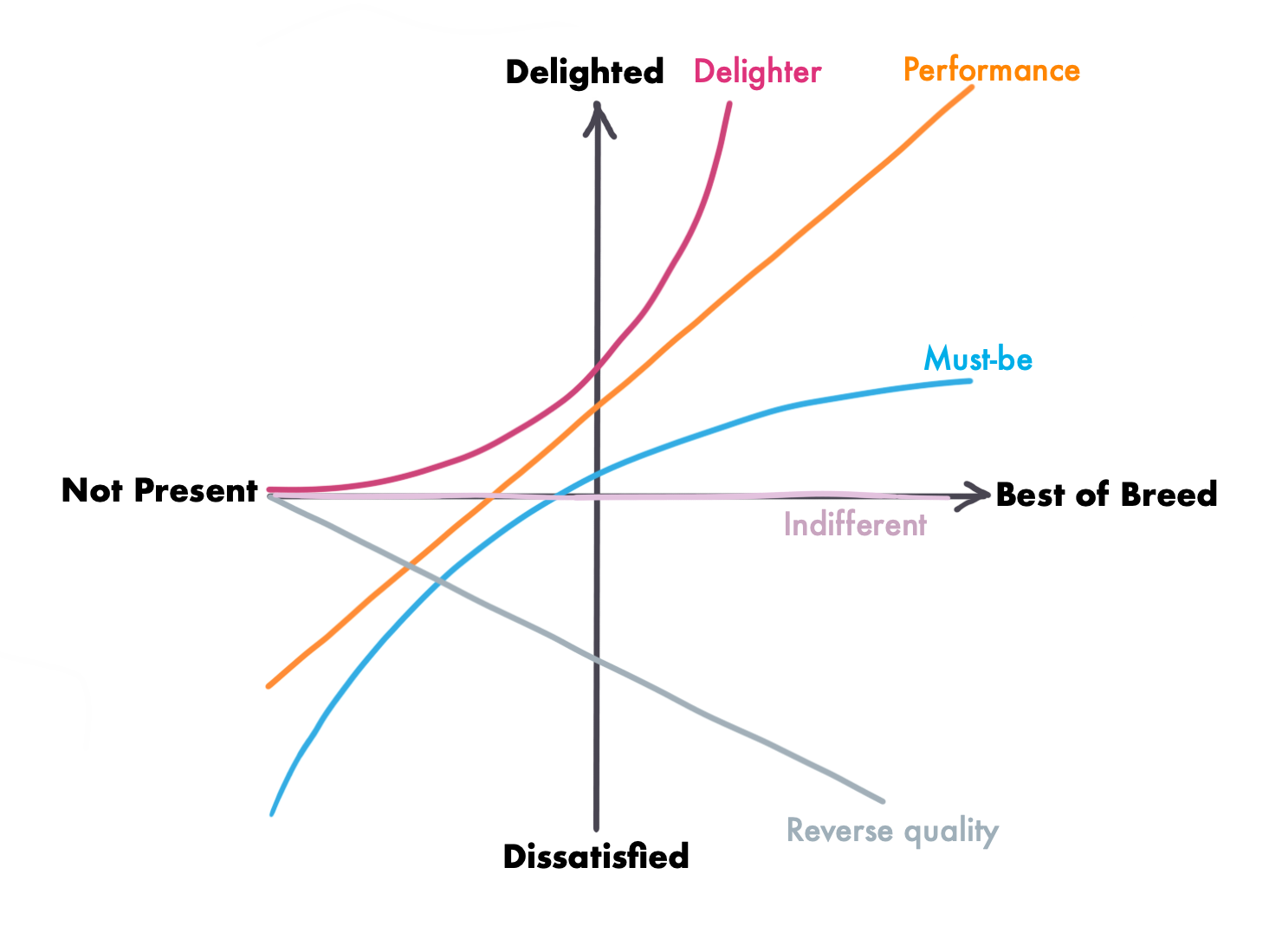
Note that in practice you don't actually have a continuous measure for each of the axes. So the chart should be understood to depict qualitative categories and is an intuitive, rough way to capture the main idea of the Kano model.
There's theory and history behind the model, but the essence is easy to understand. As an example, let's say we're a smartphone company that wants to stop shipping chargers inside the box with new phones. We could ask a sample of our customers how happy they are that their new phone came with a charger inside the box. We would offer the following scale for answers:
- I like it
- I expect it
- I'm neutral
- I can tolerate it
- I dislike it
Most people would likely respond with a positive answer (I expect it, I like it). Some may have a charger at home that they can use anyway, so they could be Neutral about it. It's hard to imagine a significant number of buyers to be dissatisfied with a free charger.
Remember, we want to stop shipping chargers inside the box by default. We'd like to know how the market will react? We could just ask our customers the obvious question: "If your new phone came without a charger in the box, how would you feel about it?". We would offer the same answer scale.
In general, take any feature f of your product and ask your customers the following two questions:
- Functional question: “How would you feel if f was present/more extensive in the product?”
- Dysfunctional question: “How would you feel if f was absent/less extensive in the product?”
If customers overwhelmingly say they expect the feature f, and would dislike it if f was absent, then you have a Must-be feature. Remove it and your product will be unsatisfactory.
If they say they don't mind f being absent, but like it when it's present, then you have a Delighter. It's an unexpected feature that gives you a competitive edge on the market. However, satisfaction will not deteriorate if you exclude the feature.
There are many possible combinations of answers and the Kano evaluation table tells us how to assign features to categories based on survey answers.
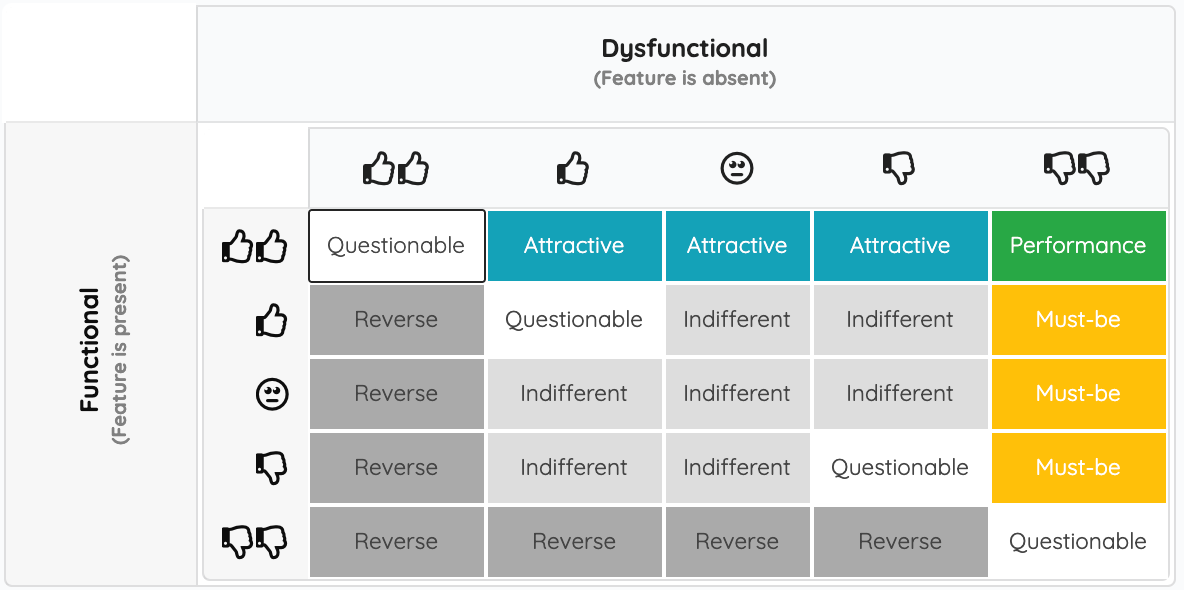
That's the basics, and now that we know what Kano model is and where it comes from, let's look at how we can use it to think about products, innovation and market competition.
Kano Model for Product Strategy and Feature Prioritization
In a 2003 paper, Kano Model: A Dynamic Approach for Classifying and Prioritizing Travellers' Requirements, we learn about the service strategy of Scandinavian Airlines (SAS).
It's presented as a pyramid of services, with fundamentals at the bottom (transfer passengers and luggage safely, on time), support services in the middle and tailoring to individual needs at the top. It's not hard to map these onto Kano categories.
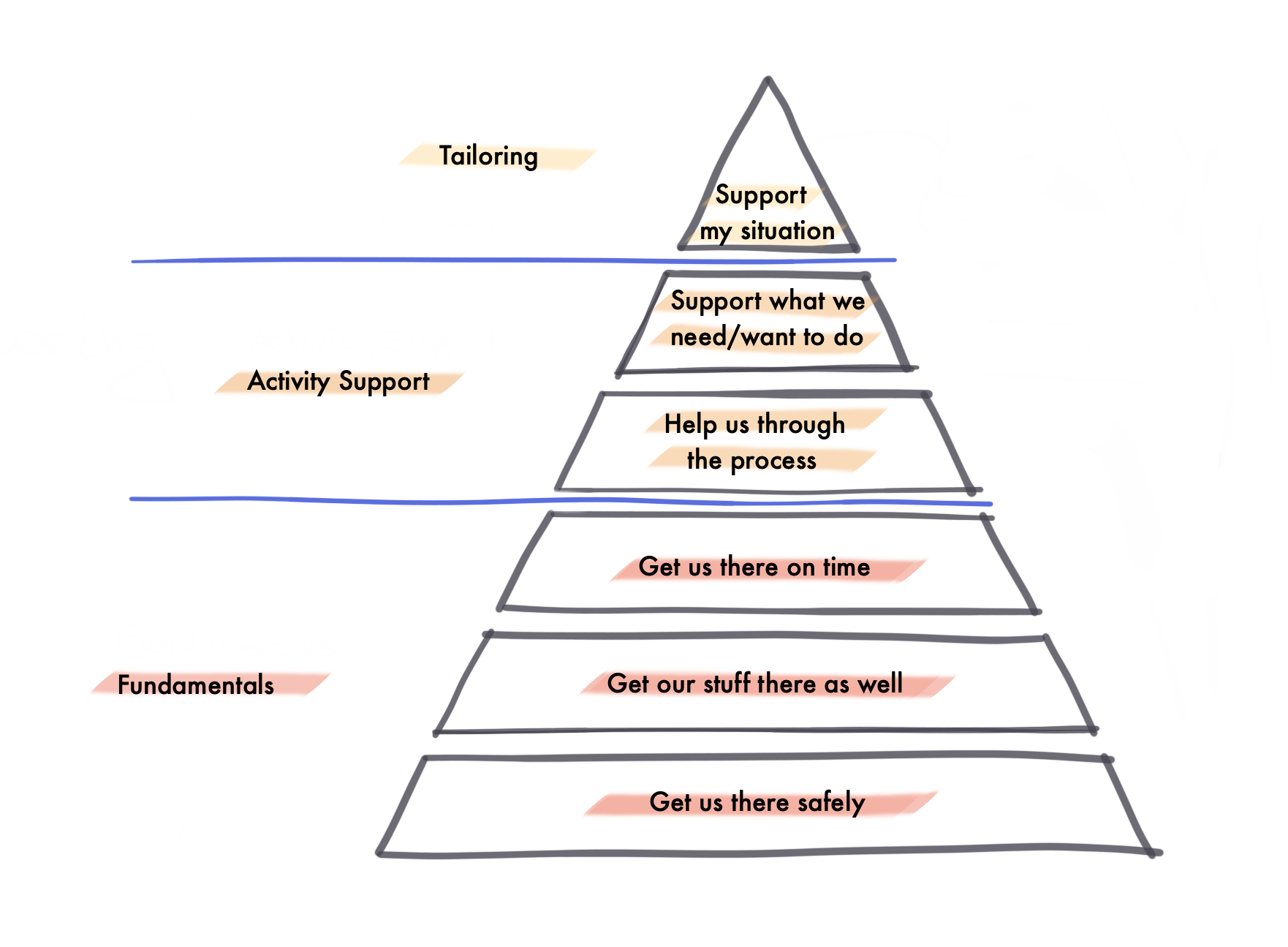
When used to prioritize of feature implementation, the pyramid nicely fits the typical prioritization heuristic used with the Kano model: get the basic stuff right (must-be attributes), be competitive at the performance features, add in delighters on top. Miss any of the foundational elements and the entire pyramid crumbles down. Leave out the top and you don't have complete, shiny, pointy pyramid.
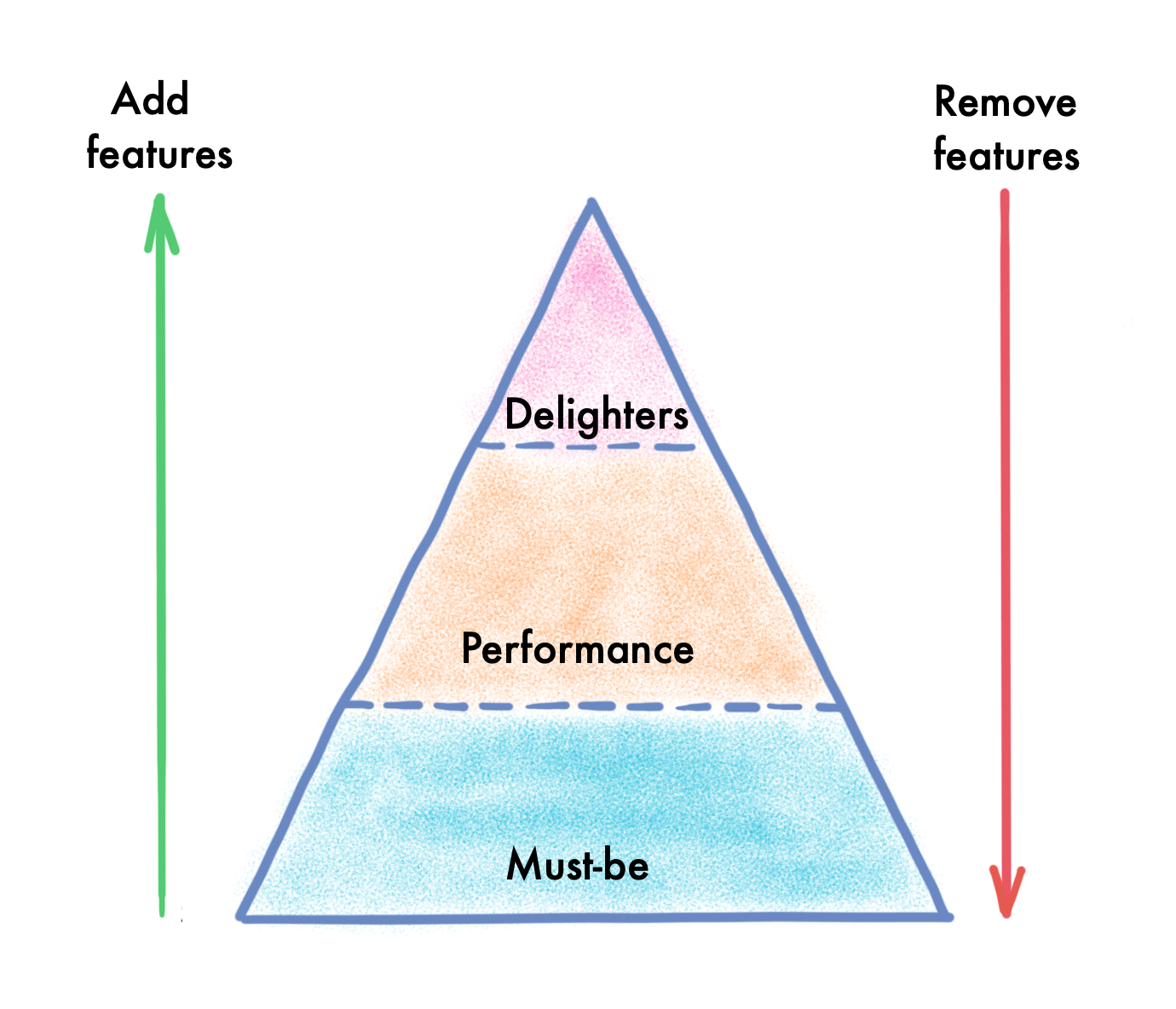
In How to build great products, Slava Akhmechet outlines an intuitive heuristic based on three buckets very similar Kano model categories:
The most important aspect of product management is categorizing features into three buckets: gamechangers, showstoppers, and distractions. When I first started building products, all features looked roughly the same. Over time, I formed the three bucket model and now my mind automatically slots every feature into one of these buckets.
Describing his heuristic using a case of building mobile phones, the author states his three feature buckets:
A gamechanger. People will want to buy your product because of this feature.
A showstopper. People won’t buy your product if you’re missing this feature, but adding it won’t generate demand.
A distraction. This feature will make no measurable impact on adoption.
Empirically, successful products have one to three gamechanging features, dozens of features that neutralize showstoppers, and very few features that are distractions. Your job is to build an intuition about your space to be able to tell these categories apart. That’s still pretty subtle (is a built-in phone projector a gamechanger or a distraction?), but at least this model gives you a plan of attack.
As Akhmechet suggests, building intuition around feature categories is an essential skill for anyone wanting to build successful products. On top of this, Kano model provides a systematic way of assessing and categorizing features. Besides the obvious, it can be a useful way of testing whether your intuition is aligned with your customers.
Removing features is another problem where Kano thinking can help. In software there's rarely reasons to remove functioning features. In service or manufacturing industries this is a massive cost-reduction mechanism. When thinking about which features to remove from your product or service, you'll likely end up going the opposite way from what we described above. You'll first consider removing delighters, reduce some performance attributes, and think very hard about must-be features.
The model is often studied as a tool for prioritization. However, mapping attributes of a product onto a pyramid like above can help prevent decay in quality of a product. Focusing too much on adding exciting new stuff and improving performance to stay competitive can cause attention to drift away from boring fundamentals.
Finding a Market for Your Product
Kano categories for a feature can vary depending on the target market and customer segment. A delighter in a budget family car will often be a basic (must-be) feature in an upmarket segment.
The set of features you're able to deliver will determine the market segment you can compete in. The market you choose will determine the entry barrier (must-be features), the areas where you can outperform competition (performance features) and the room you have to leave your customers in awe (delighters).
At any time, the current state of technology inevitably dictates what features are possible in a product. Introduction of the first Tesla Roadster is a great example of choosing the right market under such constraints. In 2006, Elon Musk shared The Secret Tesla Motors Master Plan. In it, Musk explains that with the new technology (electric motors, batteries) you can't play at the low-end market:
Almost any new technology initially has high unit cost before it can be optimized and this is no less true for electric cars. The strategy of Tesla is to enter at the high end of the market, where customers are prepared to pay a premium, and then drive down market as fast as possible to higher unit volume and lower prices with each successive model.
In part two, published in 2016, Musk adds:
Also, a low volume car means a much smaller, simpler factory, albeit with most things done by hand. Without economies of scale, anything we built would be expensive, whether it was an economy sedan or a sports car. While at least some people would be prepared to pay a high price for a sports car, no one was going to pay $100k for an electric Honda Civic, no matter how cool it looked.
Translating to Kano terminology, in economy-cars segment the price is a reverse-quality attribute, while luxury performance car buyers are mostly indifferent to high prices.

Also, as a sports car buyer you'll likely care less about practical attributes such as service network, availability of charging stations, battery range. For a budget family car owner, those are very much worth considering.
With its superior acceleration, an electric vehicle is a perfect competitor in high-performance car market. It's novelty and exclusivity are delighters that make the first generation of the Tesla roadster a perfect luxury item. So by using the technology that's not yet ready to satisfy the basic needs of the mass market, Tesla were able to cleverly craft a product that would satisfy all the basics, win on the performance and leverage novelty to delight buyers of high-performance cars.
By finding a market where your product can perfectly deliver the must-be attributes, outplay the competition in performance, and deliver enough delighters you can achieve product-market fit by choosing the market instead of changing the product.
Staying Competitive in a Tough Market
Airbnb is a famous example of disruption in a centuries-old industry. Offering unique apartments reflecting the local spirit, and at cheaper prices, Airbnb stole a large chunk of the market from traditional hotels.
The difference is well captured in a PostFunnel article titled How Airbnb Changed the Hospitality Industry:
“People who choose Airbnb are seeking an intimate, non-manufactured experience. [..] They want to be embedded in the fabric of a community, where they can feel the uniqueness of place. This desire for authenticity is driving today’s hospitality design — each hotel must tell a story; it must be a place of context, reflective of its neighborhood and community.”
The consistent, manufactured, feel of traditional hotels simply doesn't cut it. It might be an efficiency thing for hotels, making them easier to manage, equip and maintain. But for a huge segment of customers, bland hotels are unattractive. So, in Kano model terminology, this consistency would be categorized as a reverse quality attribute.


Since it's becoming an expectation (must-be) among travellers, large hotel chains are starting to transition to more cozy, residential style accommodation, connected to local lifestyle and attractions.
An article titled 4 Hotel Strategies for Remaining Competitive in the Age of Airbnb lists technology, personalization and amenities as the means for hotels to stay competitive. Referring to Kano model, this is would typically mean offering more delighters.
In Building a Winning UX Strategy Using the Kano Model Jared Spool opens his talk on Kano model with a story about Hyatt's random acts of generosity. It was a tactic intended on improving guest satisfaction and loyalty. Spool points out that we can predict such an effort to fail by observing it in the light of the Kano model. Simply put, it unlikely to help if you go out of your way to offer delighters on top of flawed must-be and subpar performance attributes.
That concludes our discussion of the Kano model and its uses.
If you're interested in more product-related reads, make sure to check out Product management on Blogboard search.
